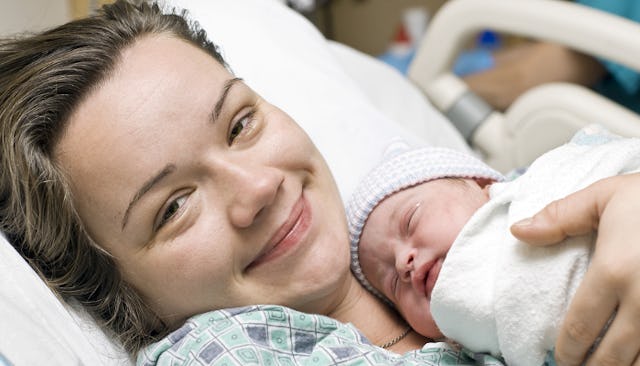This Game-Changing Surgical Drape Gives C-Section Moms A Very Special Gift

If you’ve had a c-section, you may feel something was missing. Even if it was a pleasant experience, it’s undeniable that there are certain things that just aren’t the same as with a vaginal birth. For one thing, a c-section mom can’t hold her baby against her chest immediately after birth the way a mom who gave birth vaginally is typically able to. That could all change if hospitals decide to adopt the new surgical drape created by three nurses to help make that first contact between mother and baby possible, even during a c-section.
Virginia labor and delivery nurses Kimberly Jarrelle, Deborah Burbic and Jess Niccoli felt something lacking in the c-section experience. From the Richmond Times-Dispatch, Burbic says the response often given to c-section moms requesting skin-to-skin was, “No, this is a sterile environment. We can’t do that in the operating room.” Burbic and her fellow nurses knew how meaningful skin-to-skin contact was to moms experiencing a vaginal birth and thought c-section moms should be able to feel that same closeness rather than waiting upward of half an hour until baby was all cleaned up.
Realizing there was a need, the nurses decided to do something about it. After testing out prototypes in their own homes and brainstorming ideas, the Skin to Skin C-Section Drape was born. It allows a doctor or nurse to pass the brand-new baby through a portal that can be sealed afterward, maintaining surgical sterility as the mom is stitched back up. The baby can then be observed by nurses while snuggled against its mother instead of in a warmer, as would’ve been the usual protocol with a c-section delivery.
According to Medscape, skin-to-skin contact is proven to have many benefits to both mom and baby:
Mothers who hold their newborns skin to skin after birth have increased maternal behaviors, show more confidence in caring for their babies and breastfeed for longer durations. Being skin to skin with mother protects the newborn from the well-documented negative effects of separation, supports optimal brain development and facilitates attachment, which promotes the infant’s self-regulation over time.
This is probably not a shock to hear and from my own very small sample size, I can see the benefit of merely having contact sooner, even if it’s not skin-to-skin. I had to go under for ovarian surgery after my first child was born so we were separated for several hours before I first held her. I have no way of knowing how it would’ve been otherwise, but I was anxious and depressed after her birth and definitely had trouble bonding. Contrasting that with my son, who was in my arms within about 15 minutes of his birth and breastfeeding shortly after, I see the difference. I had a much easier transition and he was a great nurser where my first child never latched and I struggled to have those maternal feelings. I can only imagine how much better the experience would’ve been in both situations had I been able to hold them against me immediately.
Not all c-section moms feel anything was missing from their birth experience, but some who were planning a natural delivery only to end up needing surgical intervention might appreciate this incredible invention. In speaking to the potential for wide-spread acceptance of this new product, Burbic says, “For some reason, they [new moms] cannot have a baby vaginally. They have to have a C-section and they get all down in the dumps, because they know that this big drape comes up, they don’t get to see their baby being born like a vaginal delivery. … This is one way we can break that barrier.” This could be a big deal for c-section mothers if hospitals around the country get on board. I can’t see any negatives from a mom being given the gift of immediate contact with her infant, even if it wasn’t the vaginal birth she was expecting.
This article was originally published on